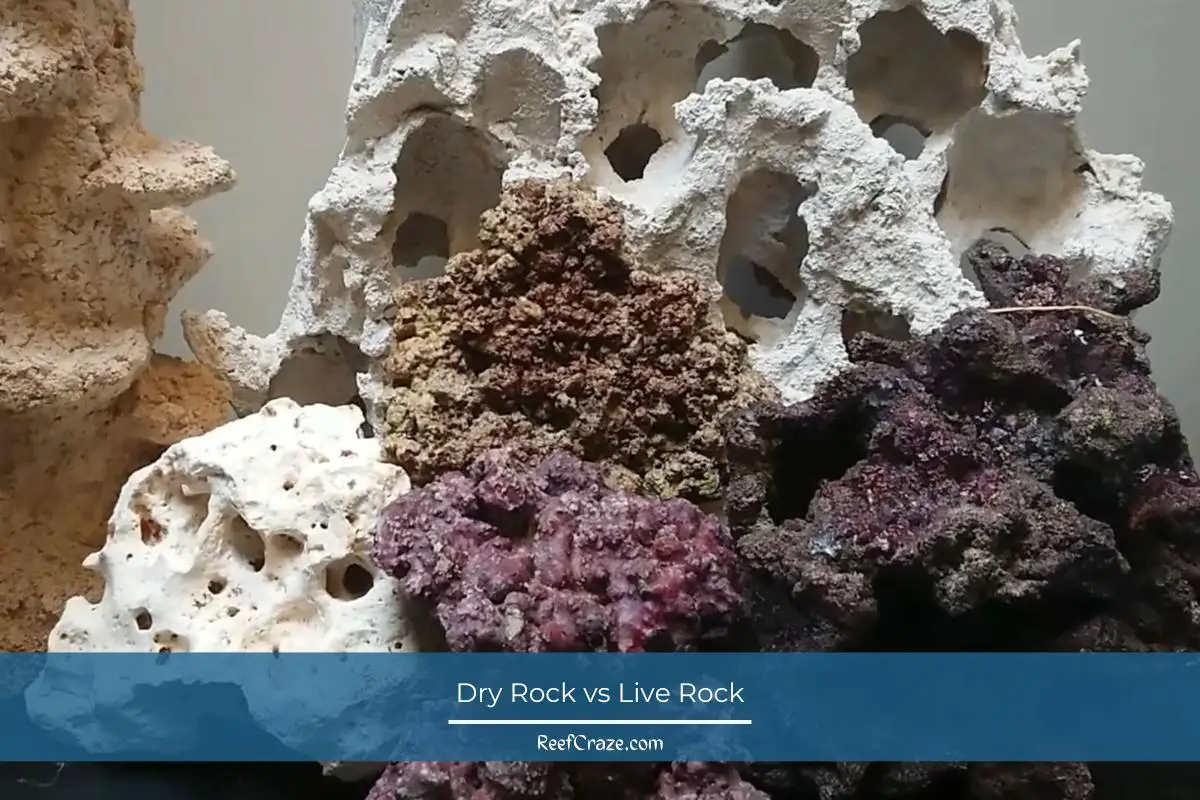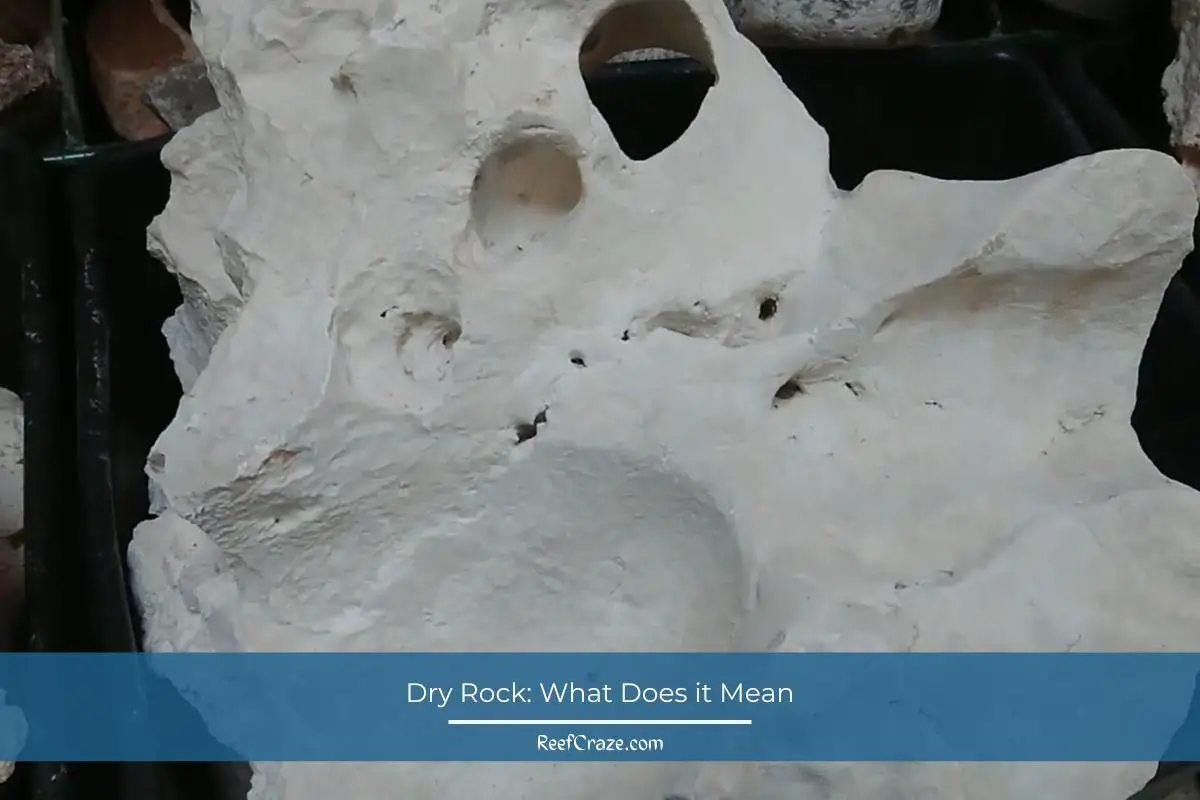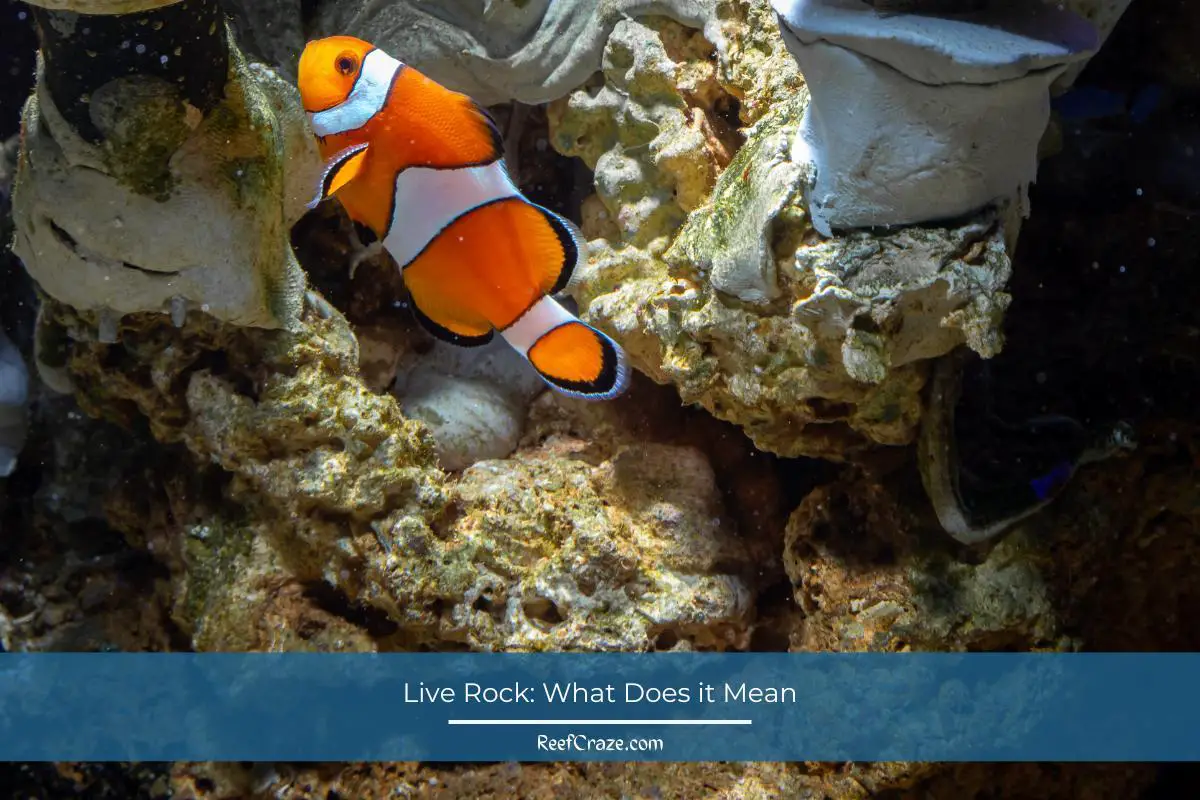Dry rock and live rock serve as the structural bedrock for marine aquariums, shaping their aesthetic appeal, biological processes, and overall ecosystem. According to a research article in the Journal of Marine Science and Engineering, these rock types, despite their stark differences, are equally capable of supporting vibrant marine life. Dry rock, as its name suggests, is devoid of life initially but offers a blank canvas for the development of a bespoke ecosystem. In contrast, live rock arrives laden with marine organisms, kickstarting the biological processes within your aquarium.
Choosing between dry rock and live rock boils down to personal preferences, specific needs of your aquarium, and a balance between immediate biodiversity and controlled ecosystem development. Live rocks provide immediate biodiversity and natural filtration at the expense of potential pests, while dry rocks provide a pest-free, customizable, and more environmentally sustainable option, albeit with a longer setup time.
As we navigate this article, we’ll discuss how these rock types influence aquarium biodiversity and water chemistry, their distinct maintenance requirements, and the environmental sustainability of each option. Each segment is packed with practical information, expert opinions, and scientific data to help you make an informed choice for your marine aquarium. So, let’s set sail into this intriguing ocean of knowledge and explore what these rocks have to offer for your undersea haven.

What is the Central Purpose of Rocks in a Marine Aquarium?
Imagine a bustling city without its concrete skyscrapers and verdant parks, or a forest without its trees. It’s hard to picture, isn’t it? In the same vein, rocks are the literal building blocks of a marine aquarium. They are the silent heroes, working behind the scenes, creating the physical and biological backbone of the ecosystem.
But how exactly do these inanimate stones contribute? Well, let’s dive in and find out.
- Structural Support: Just like an architect uses steel and concrete to create a towering skyscraper, an aquarist uses rocks to build intricate structures within the aquarium. They provide the physical base upon which corals anchor themselves and grow.
- Home Sweet Home: Picture this – you’re a tiny clownfish in a vast tank. You’d want some cozy nooks and crannies to retreat into, wouldn’t you? Rocks provide such hideouts for fish and invertebrates, providing them with a sense of security.
- A Biological Hotbed: Rocks play a critical role in biological filtration. They house beneficial bacteria that break down waste products, helping to maintain water quality. In essence, they are the unsung waste management heroes of the aquarium.
So, now that we understand why we need rocks, it’s time to take a closer look at the two main contenders – dry rock and live rock.
Understanding Dry Rock: What is it and How is it Used?
Imagine a sandy beach on a blistering summer day. Now, picture a piece of coral basking under the intense heat, all organic material breaking down and disappearing, leaving behind a bleached, bare skeleton. This, in essence, is dry rock. Often commercially manufactured, these rocks are entirely lifeless when you purchase them. However, under your careful guidance, they can bloom with life over time.

So, why do many aquarists vouch for dry rock? What makes it stand out?
Is Dry Rock Beneficial for Aquarium Health?
Dry rock has a charm of its own, offering several advantages that make it a popular choice among hobbyists. However, as with anything in life, it does come with a set of challenges. Let’s dive deeper into these.
The Pros
- Pest-Free Zone: It’s an undeniable fact. Dry rocks, devoid of any life, offer a clean slate for your aquarium. You don’t have to worry about any unwanted pests or diseases hitching a ride on these rocks. It’s akin to moving into a new house where you don’t have to deal with the previous owner’s mess. Isn’t that a relief?
- Easy on the Pocket: If you’re working on a budget, dry rock can be your best friend. It’s significantly cheaper than live rock, so you can get more bang for your buck. Who doesn’t love a good bargain, right?
- Customizability: Dry rocks are like Lego blocks – you can stack, shape, and sculpt them any way you want. They offer a world of possibilities, limited only by your imagination.
However, while dry rocks do seem like the perfect solution, they do have a couple of downsides.
The Cons
- Slow Starters: If dry rocks were athletes, they would be marathon runners. It takes time for beneficial bacteria and microorganisms to colonize these rocks. You’ll need to be patient and let nature take its course. It’s not a sprint, after all!
- Possible Contaminants: Some dry rocks, especially those that are not designed specifically for aquarium use, might contain harmful substances that can leach into the water over time. It’s crucial to purchase your rocks from a reliable source.
Armed with this understanding of dry rocks, let’s move on to the other contender in the ring – live rock.
Understanding Live Rock: What Does it Mean and Where is it Utilized?
Picture a bustling city teeming with life. Now, imagine all that life compacted into a rock. That’s what live rock is. Sourced directly from the ocean or cultured in farms, live rocks come populated with bacteria, algae, and small invertebrates. They’re like a ready-to-go kit, equipped with everything you need to kickstart your marine ecosystem.

But how do live rocks fare in the world of aquariums? Let’s delve into the pros and cons.
Can Live Rock Enhance Aquarium Ecology?
Live rock is like a surprise package. It brings a lot to the table, but it also comes with its fair share of challenges.
The Pros
- Ready-to-Go: Live rocks come loaded with beneficial organisms and bacteria. This ready-made ecosystem helps establish the nitrogen cycle quickly, reducing the time it takes for your tank to become fully functional.
- Aesthetic Appeal: There’s no denying it. Live rocks, with their varied colors and intricate formations, can make for a stunningly realistic and attractive aquarium display. Like an artist with a palette of different colors, you can create a visually appealing underwater world that’s teeming with life.
- Increases Biodiversity: Imagine moving into a neighborhood that’s already lively, with neighbors of all types. That’s live rock for you. It introduces a variety of organisms into your aquarium, thereby increasing its biodiversity, creating a richer and more vibrant underwater environment.
The Cons
- Unwanted Hitchhikers: However, not all organisms that come with live rock are welcome guests. Some can be harmful pests or invasive species that can cause significant problems in your aquarium. It’s akin to having uninvited guests crashing your house party – they might cause a mess that you’ll need to clean up later.
- Cost and Availability: Live rock can be expensive and may not always be readily available. Depending on your location, it might be as difficult to find as that needle in a haystack.
- Impact on the Environment: Another significant drawback to consider is the environmental impact. Harvesting live rock from the ocean can harm natural reef ecosystems. It’s a bit like plucking flowers from a public garden – it might make your home more beautiful, but at the expense of the shared, natural space.
Overall, live rock can indeed enhance the ecology of your aquarium if managed responsibly. It offers a shortcut to establishing a functioning, complex ecosystem, but it also comes with a responsibility to maintain the balance and health of that ecosystem. You’ve got to be the mayor, the city planner, and the health inspector, all in one!
Dry Rock vs Live Rock: Which Influences Aquarium Biodiversity More?
An important aspect to consider when selecting rocks for your aquarium is how they influence the biodiversity within your setup. The truth is, both dry and live rocks can serve as an epicenter of biodiversity, but they achieve it through different means and at a different pace.
Live Rock and Biodiversity
Live rocks enter your aquarium already teeming with a diverse array of marine life. They are jam-packed with various micro and macro organisms, such as algae, bacteria, tiny crustaceans, starfish, and worms. These microscopic tenants play a pivotal role in kick-starting the biological processes in your tank.
However, there’s an element of surprise when using live rock. It’s a bit like adopting a stray dog; you never know what it’s bringing along. Some organisms could be beneficial for your aquarium, while others might be harmful pests. Therefore, live rocks introduce an immediate, diverse ecosystem but require keen observation and possibly some pest control.
Dry Rock and Biodiversity
Dry rocks, on the other hand, start out barren and lifeless, like a vacant apartment. However, with time, patience, and proper cycling, they can become bustling hubs of life. Over several weeks, dry rocks get naturally colonized by bacteria and beneficial organisms that hitch a ride on the corals, inverts, and water you add to your aquarium.
This gradual development allows you to control what goes into your aquarium and prevent the establishment of harmful or invasive species. Dry rocks provide a slower but safer path to a diverse aquarium.
Marine biologist Dr. John E. Randall’s research suggests that the variety and number of organisms found on dry rocks can eventually match those on live rocks after a significant period (typically 6 months to a year). This highlights the fact that given time, dry rocks can contribute as significantly to biodiversity as live rocks.
How Do Dry Rock and Live Rock Affect Water Chemistry Differently?
Dry and live rocks can have different effects on your aquarium’s water chemistry. Understanding these differences can help you make an informed decision based on the specific needs of your aquatic inhabitants.
Water Chemistry and Live Rock
When you first introduce live rock to your aquarium, you may experience a spike in ammonia and nitrite levels due to the die-off of some organisms present in the rock. This is a process known as “curing” the live rock.
This initial phase might need you to monitor your water parameters closely and possibly perform water changes to maintain optimal conditions. However, once the rock is fully cured and the nitrogen cycle is established, live rock acts as a significant biofilter, helping to keep the water parameters stable.
Water Chemistry and Dry Rock
Dry rock is devoid of life and doesn’t affect the water chemistry directly upon introduction. However, its porous nature allows it to serve as an excellent biofilter over time. As the bacteria colonize the dry rock, they start converting harmful substances like ammonia and nitrites into less harmful nitrates, helping to maintain the water chemistry.
With dry rock, the process is slower and may require additional sources of ammonia to kick-start the cycling process. The upside is the lack of initial die-off or curing phase that could otherwise disrupt the water chemistry.
According to a study published in the Journal of Marine Science and Engineering, the buffering capacity and stability of water parameters in aquariums containing live rock was slightly better than those with only dry rock. This indicates that live rocks may provide better overall control over water chemistry in the long run, once the initial curing phase has passed.
Do Dry Rocks and Live Rocks Require Different Maintenance?
Yes, the maintenance required for dry and live rocks differs mainly due to their different nature.
Maintenance for Live Rock
Live rock requires a careful curing process when first introduced to your aquarium to manage the die-off of organisms. This process includes monitoring water parameters, removing dead or decaying matter, and potentially carrying out water changes.
Once established, live rocks continue to require regular maintenance. You might need to manually remove any pests or unwanted algae that may have hitchhiked in on the live rock. Think of it as tending a garden – you want to keep the beneficial plants and remove the weeds.
Maintenance for Dry Rock
On the flip side, dry rock requires less intensive initial maintenance. Since it doesn’t host any life, there’s no curing process involved. However, it’s a good idea to rinse or soak dry rock before placing it in your aquarium to remove any dust or debris.
Once in the aquarium, dry rocks require time and a source of ammonia to start the cycling process. You’ll need to monitor your water parameters regularly to ensure the nitrogen cycle is properly established. The ongoing maintenance is mainly to keep the rock clean and free from unwanted algae growth.
Are Dry Rocks More Sustainable than Live Rocks?
In terms of environmental sustainability, dry rocks are generally considered a more eco-friendly choice than live rocks.
Sustainability and Live Rock
Live rocks are typically harvested directly from the ocean, impacting the coral reef ecosystems they are taken from. The collection process can lead to habitat destruction and loss of biodiversity in these fragile marine ecosystems. This is like taking bricks from a historical building – it damages the original structure and reduces its cultural and aesthetic value.
Sustainability and Dry Rock
Dry rocks, however, are usually man-made or harvested from non-marine environments, causing minimal impact on marine ecosystems. Opting for dry rocks is similar to using recycled materials in construction – it’s a more sustainable practice and helps to conserve our natural resources.
Expert Opinions and Data
According to a report by the National Oceanic and Atmospheric Administration (NOAA), the collection of live rocks has contributed to the degradation of many coral reef habitats worldwide. On the other hand, using dry rocks in the aquarium industry can help alleviate this environmental impact.
So, if contributing to the preservation of natural habitats and biodiversity is high on your list of priorities, dry rocks are the way to go.
How Do You Choose Between Live Rock and Dry Rock?
It’s the moment of truth – time to make the decision. The choice between live rock and dry rock often boils down to your personal preferences, needs, and values.
Budget:
Dry rock typically costs less than live rock, so if you’re on a tight budget, dry rock may be the way to go. It’s like choosing between a top-tier designer outfit and a budget-friendly, yet stylish alternative – both can look great, but the costs are significantly different.
Patience and Time:
If you’re in no hurry to see your tank come to life, dry rock is a great option. On the other hand, if you prefer a quicker setup, live rock can kick-start the process.
Environmental Impact:
If environmental sustainability is a top priority for you, dry rock is the better choice. It’s similar to choosing recycled materials over new ones – a small step towards a greener earth.
Risk Tolerance:
If you prefer to play it safe and want to avoid potential pests or diseases, you might want to stick with dry rock. However, if you like surprises and are ready to tackle any challenges that come your way, live rock can make your tank more vibrant and interesting.
In the end, there’s no one-size-fits-all answer. Whether you choose live rock or dry rock, what matters is creating a healthy, balanced environment for your aquarium inhabitants.
In a Nutshell: Dry Rock vs Live Rock – The Final Verdict
Choosing between dry rock and live rock is a personal journey. It’s about balancing your desires, concerns, and capabilities to create a mini marine world that’s uniquely yours.
Remember, you’re not just creating an underwater spectacle – you’re also responsible for preserving the vibrant life within it. Like being a gardener in an underwater garden, the choices you make can profoundly impact the health and vibrancy of your marine inhabitants.
Dry or live, every rock has the potential to be a thriving cornerstone of your aquarium. The magic lies in your hands. It’s your love, care, and commitment that will ultimately turn these rocks into a stunning underwater paradise. So choose wisely, plan carefully, and happy aquascaping!

